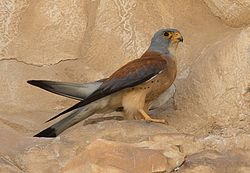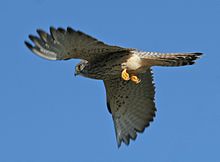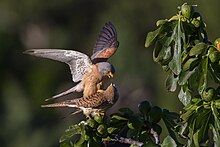Red hawk
| Red hawk | ||||||||||||
|---|---|---|---|---|---|---|---|---|---|---|---|---|
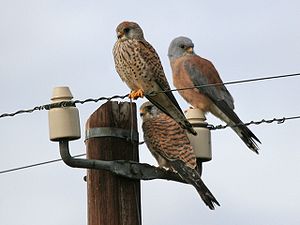
Male and two females |
||||||||||||
| Systematics | ||||||||||||
|
||||||||||||
| Scientific name | ||||||||||||
| Falco naumanni | ||||||||||||
| Butcher , 1818 |
The red chalk hawk ( Falco naumanni) is a small falcon that lives primarily in the Mediterranean region and Central Asia. It resembles a kestrel and should not be confused with its regional name Rüttelfalke . No subspecies are described.
Red falcons are primarily inhabitants of open, dry, warm landscapes such as steppes or semi-deserts, but they also colonize extensively used cultivated land. They feed mainly on insects and other arthropods , but also on small vertebrates . The animals migrate long distances and overwinter in sub-Saharan Africa.
The red hawk has suffered severe population losses in Europe since the 1960s, but has been increasing regionally in recent years. The species is classified by the IUCN as Least Concern ("not endangered") worldwide .
Appearance
In size and appearance, the species is similar to the kestrel . In all clothes, both sexes of the red hawk have very light, whitish claws, these are black in the kestrel. With a body length of 29–32 centimeters, the red chalk hawk is somewhat smaller than the kestrel, the tail appears more wedge-shaped due to the somewhat elongated central feathers. On the underside, the tail is lighter than that of the kestrel; it ends in a relatively wide, white-lined end band. The dotted lines on the underside of the abdomen appear more punctiform or ring-shaped in the red hawk. In the male, the upper side of the wing is reddish-brown, in contrast to the kestrel, however, without black spots. The male's head is slate gray. From the bow of the wing to the inner arm wings, a slate-gray band can also be seen on the upper wing, which is missing in the male kestrel.
Young red falcons do not have this wing band either. The wingspan is 58-72 centimeters. Females and juveniles are very similar to the kestrel, the best distinguishing features are the lighter undersides of the hand and arm wings compared to the kestrel, which contrast clearly with the under wing coverts. In terms of behavior, occurrence and voice, the two species differ very clearly, so that a reliable determination is almost always possible.
The females are only slightly larger and heavier than the males, the weight of the birds varies between 130 and 200 grams.
voice
As a colony breeder, the red chalk hawk is very fond of reputation. All of his vocalizations have a somewhat hoarse, sometimes rattling timbre and appear muted, not shrill and shrill like birds of prey. One often hears a little vocalized, polysyllabic “Che-chee” from these birds. This sequence of calls varies greatly and becomes more glaring as the excitement increases, for example "gii-gik". During the mating season, a trembling, rising leaning (begging for food) ("die - die - die", sometimes also "huiirr" or "iiieerrr") can be heard from the female .
distribution
The range of the species is in the southern and central Palearctic , mainly between 30 ° and 50 ° north. In the west, the occurrences begin on the Moroccan and Portuguese Atlantic coast and continue in a relatively narrow strip to the east. There are strongly fluctuating stocks in the Maghreb states , in Portugal and Spain , in southern France as well as in southern and central Italy including the large islands, in the Balkans and then eastwards in the steppe areas of Ukraine and European Russia ; in Greece and on some of the larger Greek islands, Turkey , as well as in some countries bordering the eastern Mediterranean, the species is also breeding bird. These breeding areas continue eastward in Asia and extend into Mongolia and a little further south to central China . Pure high mountain regions and pure deserts are also spared in this distribution area, but foothills are populated up to heights of up to 3000 meters. High-altitude breeding areas are, for example, in the area around Lake Sevan in Armenia or in Tianshan . The southernmost breeding areas are in northern Iraq , Iran and Afghanistan . The deposits in Asia are also subject to great fluctuations.
Central Europe was always on the northern limit of the species distribution. All central European deposits are currently extinct.
habitat
The red chalk falcon is an inhabitant of open, dry, heat-favored and, above all, landscapes such as steppes or semi-deserts. To do this, it colonizes extensively used cultivated land if it finds breeding opportunities and a high density of prey. Pure deserts are only populated in their peripheral areas, closed forest stands are avoided entirely; Even wetlands are not used as a habitat by this species. Otherwise, however, the red chalk hawk seems to be quite flexible in terms of habitat structure. In the wintering area, too, it appears in similar, heat-favored, dry and large insect-rich habitats. Often red hawks can be found following other predators in the vicinity of bush or steppe fires, where they use the supply of fleeing insects, small mammals and small reptiles.
Although many of the colonies are in very isolated and almost deserted areas, the species is by no means hemerophobic . Where there is sufficient tolerance by humans, colonies have also been found on the outskirts of cities or villages, even in the middle of large cities, such as Seville , where there is a breeding colony with a few dozen couples at the Maria de la Sede Cathedral . In addition to the nesting site, the food supply in the immediate vicinity of the breeding site is limiting for its breeding occurrence.
behavior
Red- footed falcons are, like red-footed falcons, extremely sociable birds that are rarely found individually or breed as single pairs. Most of the time they live in colonies and go to catch prey together - both in the breeding grounds and in the wintering areas. Before the populations fell sharply, breeding colonies with a few hundred pairs and migrant communities with a few thousand individuals were not uncommon.
A late start to activity, a pronounced rest at noon and flight hunts until late at dusk characterize the daily rhythm of the red chalk falcon. At times, especially when artificial light sources attract large flocks of insects, red hawks can be found hunting in the early hours of the night. Its flight is less hasty than that of the kestrel, and the shaking is more gliding and floating. Often, updrafts along rock walls or tall buildings are used to stand in the air, with the constantly rotating and turning tail compensating for the air currents.
The immediate vicinity of the breeding site is defended against conspecifics with threatening gestures, but there are no actual physical attacks. Potential enemies entering the breeding colony, such as crows or birds of prey, are flown around by many colony members, but are not attacked particularly vigorously. Red hawks also show a rather passive behavior towards humans with a noticeably short flight distance.
The red chalk hawk is a cave or half-cave breeder that usually breeds in colonies. Colonies with more than a hundred breeding pairs have become rare today. The individual breeding sites within a colony are sometimes only a little more than 2 meters apart.
Like all falcons, red hawks do not build nests; they are therefore dependent on the availability of suitable nesting facilities, especially in caves, semi-caves or ledges. They can be found in tree hollows, niches in loess quarries or in sandstone rocks, in rock niches and covered ledges as well as in wall niches on buildings. Occasionally red hawks breed in tree hollows or nests of other bird species. Nest box broods were also known. Nesting material is not entered, but the breeding site is cleaned and, if possible, slightly hollowed for egg-laying.
Red falcons return unmated from the wintering area. Immediately after arriving at the breeding site, the males, which usually arrive first, begin sightseeing in the vicinity of the future breeding site; After the arrival of the females, these flights are intensified, the most obvious element of which is body rotations of almost 180 degrees, so that the male flies back down for a short time. This phase is followed by relatively long courtship feedings, in which the female crouched down , laughing , takes over the prey and then flies off immediately.
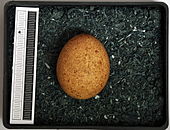
Red falcons lead a mostly monogamous breeding season, but polygyny has been observed. They become sexually mature in their first year of life, but usually do not brood until they are two years old, and more rarely even when they are three years old. The majority of the annual young birds spend the first half of the summer in their winter quarters; returning, non-breeding males year participate occasionally as breeding helpers in the breeding season. The clutch consists of 3–6, mostly 4–5 eggs with reddish brown spots on a light brown background. They measure an average of 35 × 28 millimeters. The clutch is incubated by both parents during the day, but almost exclusively by the female at night. The young hatch after about 28 days. Both parents feed and look after the young. The nestling duration is very different from region to region: It seems to depend heavily on weather conditions and the availability of food. It can be a little less than thirty days, but it can also be almost forty. The time the young birds are guided and how long they stay in the parent colony is remarkably short, after which the young migrate widely, often in a northerly direction, before they begin their migration to the African winter quarters, usually at the beginning of August. Second broods occur, but are rather rare in the European observation area.
Food and subsistence
The diet of the red hawk consists of a large number of prey animals, but often mostly insects. It mainly prey on crickets , grasshoppers and various beetles , sometimes also millipedes and scorpions , especially in spring also small mammals and reptiles . In the winter quarters, different species of locusts and termites belong to the prey. Its predominantly insectivorous diet is proven by most dietary analyzes. The prey is discovered in search flight , shaking flight or from a control room and is usually caught or beaten on the ground. Often it is consumed in flight, larger prey are carried to a hide. In the evenings, hunting predominates. The red hawk's range of action depends on the availability of food. In optimal breeding habitats, it only uses a noticeably small hunting area, which as a rule does not significantly exceed a radius of 1–1.5 kilometers around the breeding site.
Migratory behavior
Almost all red hawks are obligatory remote migrants and overwinter in sub-Saharan Africa. All European populations move to these areas and apparently also the Central Asian ones. Only a few old males try to overwinter in southern Spain, Morocco , the southern Balkans and southern Turkey. In the wintering areas, the red hawks lead a nomadic life, so that they can be found in large parts of Africa south of the Sahara . Their occurrence is essentially determined by the regional mass occurrence of large insects. Overall, however, too little is known about the migration behavior and the precise delimitation of the wintering areas. In the late winter of 2007, French ornithologists discovered a resting place in Senegal, where around 28,600 red hawks gathered.
The move begins in July with an undirected intermediate move, so that the actual start of the move is difficult to determine. The Mediterranean and Sahara are likely to be flown over directly and at high altitude, as no particular clusters were found at the known bottlenecks ( Bosphorus , Gibraltar ). Non-stop flights of 2000 km and more were recorded. He may be pulling a loop , but there is little reliable information about the migration behavior of this species. They arrive in their winter quarters from mid-October, and they start moving home in January. The birds arrive in North Africa around mid-February, the birds that breed in Spain, southern Italy and Greece are observed there from March, and the first red falcon to breed in Styria arrived at their breeding sites there almost exactly on April 1st .
Existence and endangerment
The red hawk has suffered severe population losses in Europe since the 1960s. In 1960 there were still almost 300 breeding pairs in Styria and Carinthia , which were spread over several colonies. The last proof of breeding was made in 1984. The development in Hungary was just as dramatic . Since the 1980s, the red hawk population has collapsed catastrophically in Spain as well : in 1960, the population was estimated at around 100,000 breeding pairs; at present it is slightly more than 10,000, after their number had dropped to below 5,000 in the mid-1990s. Worldwide there is only 10 to 15% of the population from the 1950s. For some years now, however, somewhat more positive tendencies have appeared again: For example, the population in Spain - at a low level - has been stable for some years, and considerable numbers of breeding pairs have been reported from Greece and Macedonia. The species is currently increasing particularly rapidly in Italy, where there is also a considerable expansion of the area to the north. The total European population is estimated at around 30,500–38,000 breeding pairs.
The existence of the lesser kestrel is by the IUCN as to not endanger classified ( "Least Concern").
The population dynamics of this species have always been very large - some colonies emerged, grew quickly and then disappeared again. This natural fluctuation can hardly explain the sharp decline in stocks in the 1960s. It is possible that this species suffers particularly badly from the control of migratory locusts in the wintering areas. In the breeding areas, habitat destruction, a lack of prey due to the introduction of biocides and possibly the more Atlantic climate in Central Europe have accelerated the collapse of the species. A lack of genetic exchange can also contribute to the collapse of some colonies.
Name derivation
The scientific species name naumanni goes back to Johann Andreas Naumann, the father of Johann Friedrich Naumann .
Individual evidence
literature
- James Ferguson and David A. Christie: Raptors of the World. Houghton Mifflin Company Boston, New York 2001. pp 835-338; 92. ISBN 0-618-12762-3
- Urs N. Glutz von Blotzheim (Hrsg.): Handbook of the birds of Central Europe . Vol. 4. Edited by Kurt M. Bauer and Urs N. Glutz von Blotzheim, among others. Aula-Verlag, Wiesbaden, 1989, pp. 741-767. ISBN 3-89104-460-7
- Theodor Mebs and Daniel Schmidt: The birds of prey in Europe, North Africa and the Middle East. Biology, characteristics, stocks. Franckh-Kosmos Verlag GmbH & Co. KG, Stuttgart 2006. pp. 464-471. ISBN 3-440-09585-1
- Hans-Günther Bauer and Peter Berthold : The breeding birds of Central Europe. Existence and endangerment. Aula-Wiesbaden 1998 pp. 88-89. ISBN 3-89104-613-8
- Mark Beaman and Steven Madge: Handbook of Bird Identification. Europe and Western Palearctic. Ulmer-Stuttgart 1998. S 205 and 245. ISBN 3-8001-3471-3
- Viktor Wember: The names of the birds of Europe. Meaning of the German and scientific names. Aula-Wiebelsheim 2005, p. 62. ISBN 3-89104-678-2
- Benny Génsbol, Walther Thiede: Birds of prey - All European species, identifiers, flight images, biology, distribution, endangerment, population development. BLV Verlag, Munich 1997. ISBN 3-405-14386-1
Web links
- factsheet from birdlife international 2005; Distribution map , wintering areas (unfortunately, the illustration is unusable!)
- factsheet birdlife europe 2004 (PDF file; 250 kB)
- Good distribution map for Europe ( Memento from September 25, 2005 in the Internet Archive ) (useful image)
- Falco naumanni in the Red List of Threatened Species of the IUCN 2008. Posted by: BirdLife International, 2008. Accessed January 31 of 2009.
- Videos, photos and sound recordings of Falco naumanni in the Internet Bird Collection
- Age and gender characteristics (PDF; 3.5 MB) by J. Blasco-Zumeta and G.-M. Heinze (eng.)
- Feathers of the red hawk
